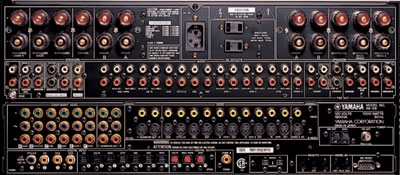Yamaha RX-Z9 THX Ultra2 Digital Surround Receiver Page 2
It's also unusual for a receiver to have i.Link (a.k.a. FireWire) ports, which are usually found on computers and DV camcorders. While the RX-Z9's two i.Link inputs respond only to digital audio, they're among its most significant features. If you have one of the few i.Link-equipped DVD-Audio or Super Audio CD players, you'll be able to feed high-resolution multichannel audio directly to the receiver in digital format. These inputs also allow the RX-Z9 to apply its massive powers of digital signal processing (DSP) to all multichannel audio formats - Dolby Digital and DTS as well as DVD-A and SACD - without any potentially signal-degrading cycles of analog-to-digital conversion. Among those processing powers are a bass-management system that operates on all formats and input signals - including those coming in through the multichannel analog jacks and the digital i.Link connectors. We've been waiting years for manufacturers to get this right! If this receiver is properly set up, you won't hear a change in bass balance as you switch from, say, a CD to a DVD movie to an SACD to an HDTV broadcast. 
Equally important, and even more extraordinary, is a speaker-distance compensation system that also operates on all signals and formats. For the first time in our listening room, I was able to hear the same kind of solid, in-focus imaging from SACDs that DVD-Audio and even Dolby Digital and DTS programs have benefited from for years. While distance compensation may not be as "sexy" as some of the other features, if you want the best possible reproduction of SACDs, the RX-Z9 is one of only a handful of receivers to offer this refinement.
On the other hand, the Yamaha Parametric Room Acoustic Optimizer, or YPAO, definitely qualifies as sexy. This system completely relieves the user of the burden of setting up the receiver for multichannel operation. You'll never have to balance the speaker levels, measure the distance of each speaker from the prime listening position, nor (the toughest part) adjust the subwoofer controls to produce the flattest possible response in the crossover region between the subwoofer and the main speakers. With YPAO, all you do is set up the small supplied microphone at your listening position, select a few basic preferences from onscreen menus, and then select Start. After a couple of minutes of hissing, thumping, whooping, and roaring test signals, your system will be completely set up. And I mean completely.





























































